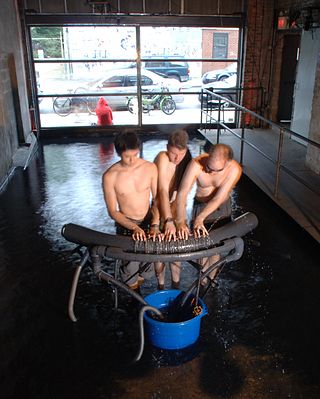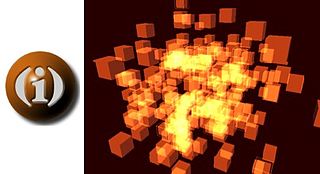Computer music is the application of computing technology in music composition, to help human composers create new music or to have computers independently create music, such as with algorithmic composition programs. It includes the theory and application of new and existing computer software technologies and basic aspects of music, such as sound synthesis, digital signal processing, sound design, sonic diffusion, acoustics, electrical engineering, and psychoacoustics. The field of computer music can trace its roots back to the origins of electronic music, and the first experiments and innovations with electronic instruments at the turn of the 20th century.
A music sequencer is a device or application software that can record, edit, or play back music, by handling note and performance information in several forms, typically CV/Gate, MIDI, or Open Sound Control, and possibly audio and automation data for digital audio workstations (DAWs) and plug-ins.

The Jesus and Mary Chain are a Scottish alternative rock band formed in East Kilbride in 1983. The band revolves around the songwriting partnership of brothers Jim and William Reid, who are the two founders and only consistent members of the band since its formation. They are recognized as key figures in the development of the shoegaze and noise pop subgenres. The band have had twelve top 40 entries and two top 10 hits in the UK Singles Chart in the course of their career.

Multitrack recording (MTR), also known as multitracking, is a method of sound recording developed in 1955 that allows for the separate recording of multiple sound sources or of sound sources recorded at different times to create a cohesive whole. Multitracking became possible in the mid-1950s when the idea of simultaneously recording different audio channels to separate discrete "tracks" on the same reel-to-reel tape was developed. A "track" was simply a different channel recorded to its own discrete area on the tape whereby their relative sequence of recorded events would be preserved, and playback would be simultaneous or synchronized.
Music information retrieval (MIR) is the interdisciplinary science of retrieving information from music. Those involved in MIR may have a background in academic musicology, psychoacoustics, psychology, signal processing, informatics, machine learning, optical music recognition, computational intelligence or some combination of these.

GarageBand is a software application by Apple for macOS, iPadOS, and iOS devices that allows users to create music or podcasts. GarageBand was originally released for macOS in 2004 and brought to iOS in 2011. The app's music and podcast creation system enables users to create multiple tracks with pre-made MIDI keyboards, pre-made loops, an array of various instrumental effects, and voice recordings.

ChucK is a concurrent, strongly timed audio programming language for real-time synthesis, composition, and performance, which runs on Linux, Mac OS X, Microsoft Windows, and iOS. It is designed to favor readability and flexibility for the programmer over other considerations such as raw performance. It natively supports deterministic concurrency and multiple, simultaneous, dynamic control rates. Another key feature is the ability to live code; adding, removing, and modifying code on the fly, while the program is running, without stopping or restarting. It has a highly precise timing/concurrency model, allowing for arbitrarily fine granularity. It offers composers and researchers a powerful and flexible programming tool for building and experimenting with complex audio synthesis programs, and real-time interactive control.

Live coding, sometimes referred to as on-the-fly programming, just in time programming and conversational programming, makes programming an integral part of the running program.

New Interfaces for Musical Expression, also known as NIME, is an international conference dedicated to scientific research on the development of new technologies and their role in musical expression and artistic performance.

Eduardo Reck Miranda is a Brazilian composer of chamber and electroacoustic pieces but is most notable in the United Kingdom for his scientific research into computer music, particularly in the field of human-machine interfaces where brain waves will replace keyboards and voice commands to permit the disabled to express themselves musically.

The Yamaha Tenori-on is an electronic musical instrument designed and created by the Japanese artist Toshio Iwai and Yu Nishibori of the Music and Human Interface Group at the Yamaha Center for Advanced Sound Technology.

The use of electronic music technology in rock music coincided with the practical availability of electronic musical instruments and the genre's emergence as a distinct style. Rock music has been highly dependent on technological developments, particularly the invention and refinement of the synthesizer, the development of the MIDI digital format and computer technology.

Impromptu is a Mac OS X programming environment for live coding. Impromptu is built around the Scheme language, which is a member of the Lisp family of languages. The source code of its core has been opened as the Extempore project.
Artificial intelligence and music (AIM) is a common subject in the International Computer Music Conference, the Computing Society Conference and the International Joint Conference on Artificial Intelligence. The first International Computer Music Conference (ICMC) was held in 1974 at Michigan State University. Current research includes the application of AI in music composition, performance, theory and digital sound processing.
The Music Encoding Initiative (MEI) is an open-source effort to create a system for representation of musical documents in a machine-readable structure. MEI closely mirrors work done by text scholars in the Text Encoding Initiative (TEI) and while the two encoding initiatives are not formally related, they share many common characteristics and development practices. The term "MEI", like "TEI", describes the governing organization and the markup language. The MEI community solicits input and development directions from specialists in various music research communities, including technologists, librarians, historians, and theorists in a common effort to discuss and define best practices for representing a broad range of musical documents and structures. The results of these discussions are then formalized into the MEI schema, a core set of rules for recording physical and intellectual characteristics of music notation documents. This schema is expressed in an XML schema Language, with RelaxNG being the preferred format. The MEI schema is developed using the One-Document-Does-it-all (ODD) format, a literate programming XML format developed by the Text Encoding Initiative.
Sergi Jordà is a Catalan innovator, installation artist, digital musician and Associate Professor at the Music Technology Group, Universitat Pompeu Fabra in Barcelona. He is best known for directing the team that invented the Reactable. He is also a trained Physicist.
Sound and music computing (SMC) is a research field that studies the whole sound and music communication chain from a multidisciplinary point of view. By combining scientific, technological and artistic methodologies it aims at understanding, modeling and generating sound and music through computational approaches.
Rui Penha (Porto, October 16, 1981 - Porto, is a Portuguese musician, composer, and conductor.

Carl Haakon Waadeland is a Norwegian musicologist and jazz drummer, known from several bands and releases such as with Dadafon, Dum Dum Boys, Åge & Sambandet, Halvdan Sivertsen, Warne Marsh, Kenny Wheeler, Annbjørg Lien, Henning Sommerro, Bjørn Alterhaug, John Pål Inderberg, Knutsen & Ludvigsen, Mikis Theodorakis and Arja Saijonmaa. He was one of the driving forces behind the jazz program at NTNU which he also directed.

Eric Singer is a multi-disciplinary artist, musician and software, electrical, computer, robotics, and medical device engineer. He is known for his interactive art and technology works, robotic and electronic musical instruments, fire art, and guerilla art.











